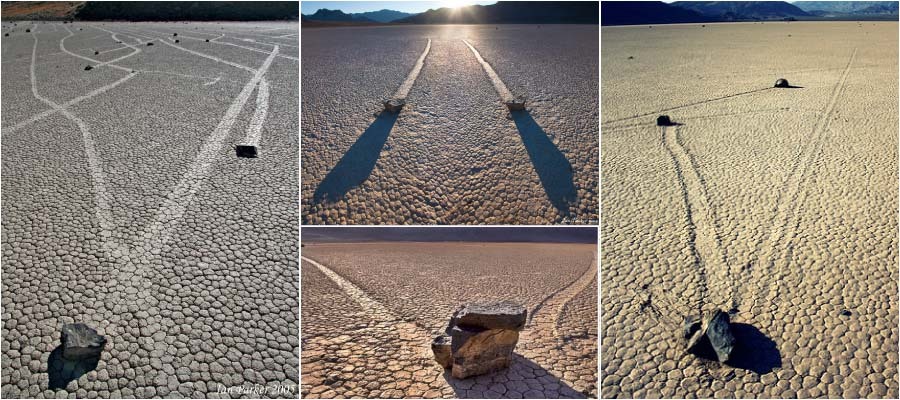
|
|||
Mystery of Death Valley's 'Sailing Stones' Solved - Unexplained Mysteries
See more at: http://www.washingtonpost.com/news/morning-mix/wp/2014/08/28/scientists-may-have-solved-the-mystery-of-death-valleys-sailing-stones/
The Racetrack Playa — a barren lakebed in Death Valley National Park — is home to one of the world’s natural wonders: "sailing stones" that mysteriously meander across the dried mud, leaving tracks in their wake. Since the 1940s, these rocks have fueled wonder and speculation because no one had seen them in action — until now. A team of U.S. scientists recorded the first observation of these boulders in motion, using GPS monitors and time-lapse photography. By meticulously tracking weather data, scientists also explained how these rocks slog across the playa. What was one of the world’s natural wonders now appears to be the perfect combination of rain, wind, ice and sun.There’s a barren lake bed in the Death Valley National Park in California defined by its many long serpentine tracks, etched into the landscape by massive stones that move somewhat miraculously across the mud. After decades of theories and attempts to solve the mystery of Death Valley's sailing stones, a trio of scientists has finally caught the process on tape. Their study started years ago, when two of them (a biologist and an engineer) hauled 15 GPS-equipped rocks onto Racetrack Playa, the dry lake where the famous stones are found. It wasn't until 2013, when a planetary scientist made their two-man band a trio, that they hit the jackpot, though. Apparently, it takes a precise combination of water, ice and wind for the rocks to move. First, the water that floods the lake (which happens rarely) should be around three inches deep, so when it freezes, it forms thin, windowpane-like ice sheets beneath the rocks. Then, it should be sunny the day after that in order for the ice to crack, and for 10MPH winds to propel the rocks forward. 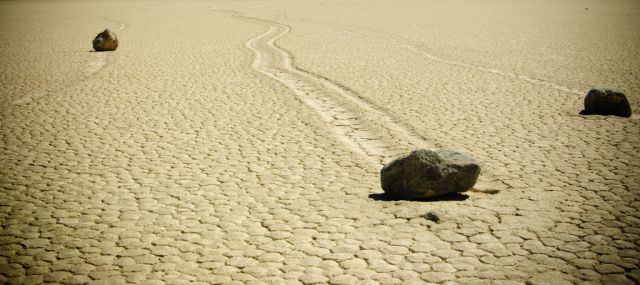 It’s called Racetrack Playa — and for decades geologists have been chasing the "sailing stones" at play there. One of the first scientific studies, published in 1948, suggested the rock motion was driven by dust devils. Most recently, a couple of U.S. scientists hypothesized it was hurricane-force winds that were doing the deed. But it wasn’t until now that science has revealed a plausible explanation for how these stones leave their "racetrack" imprints through the playa: It takes a kind of perfect storm. The Racetrack Playa must first fill with water — deep enough to float massive sheets of ice, yet still shallow enough to leave the rocks exposed. Nighttime temperatures must then get cold enough to freeze the water, forming mammoth-size ice panes — thin enough to glide across the lake bed, yet thick enough to gain momentum and clear the stones in their way. As the next day’s afternoon sun thaws the ice, these sheets break apart into chunks that, with any luck, a steady wind will propel across the playa pool. When the ice chunks hit the rocks — ranging from pebble to boulder-size pieces weighing up to 200 pounds – the stones are driven across the soft mud below, leaving behind their signature trails. All authors agree that rocks are most likely to move when the playa surface is wet, creating a slick surface, and that wind must be involved. The first scientific study of the Racetrack suggested that rock motion was driven by dust devils . This idea was tested using the wash of an aircraft propeller over wetted surfaces of Racetrack Playa ; these experiments showed that winds more than 20 m/s could move natural rocks. Shelton suggested that other factors, including the presence of algal films might help to lower the frictional forces resisting rock motion under strong winds. W. Sharp carried out static and dynamic friction tests using rocks towed across wet and dry mud surfaces and calculated that wind velocities of 33–45 m/s would be needed for rock movement. Additional calculations for rocks of various sizes and sail heights showed that most rocks would move across a wetted playa surface where the coefficient of static friction is about 0.15 and wind velocities were >40 m/s . Still other static friction tests suggest the need for even higher wind velocities (up to 80 m/s), particularly to move rocks with relatively low profiles . All these experiments suggest that very high winds are needed for rock movement.
Getting the Green Light Past theories attributed the rocks’ movements to high winds, liquid water, or ice. But scientists discovered it’s a careful balance of all these factors. When the small pond formed in the southern portion of the playa, it cyclically froze at night and thawed under the midday sun. When the sun warmed the pond, thin layers of surface ice started breaking apart into massive floating sheets tens of meters in size. Although the ice sheets were large, they were still just a few millimeters thick. 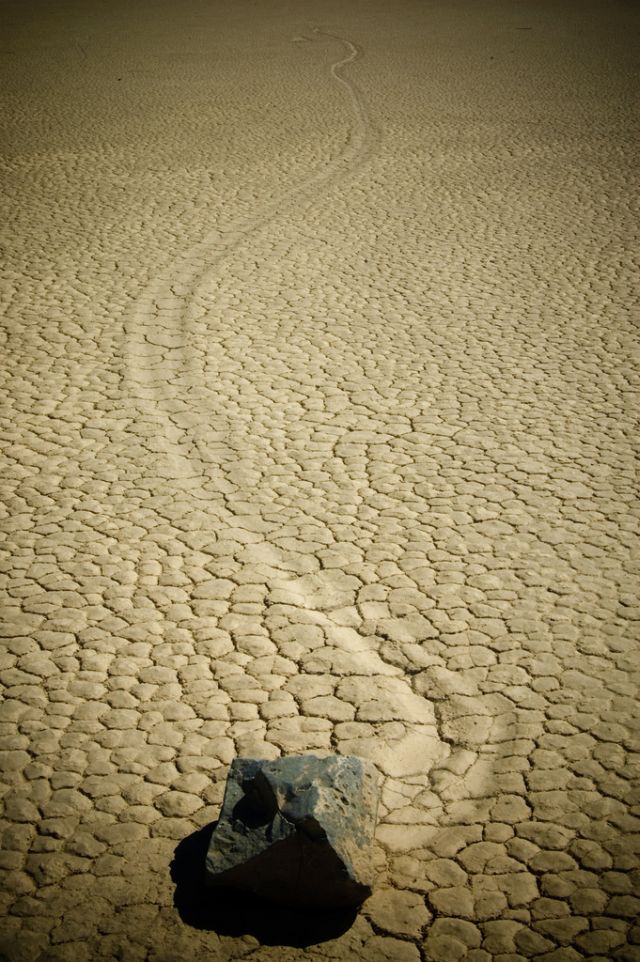 But the freezing and thawing wasn’t enough on its own. A steady, light wind of about 7-10 miles per hour was also needed, but before the ice had completely melted. This wind, timed with the midday melt, pushed massive panes of ice into the stones. When the ice accumulated behind the stones, it generated enough force to set the stones into motion. And rather than floating or rolling, the rocks bulldozed their way across the mud, leaving behind their signature tracks. Researchers published their findings Tuesday in the journal PLoS ONE. The rocks won’t move if there’s too much water or ice, too much sun, or not enough wind. Everything must act in perfect harmony for the races to ensue. So, in addition to their "sailing stones" moniker, we suggest a new name for these fascinating boulders: the Goldilocks Rocks. Richard Norris, 55, a paleobiologist at the Scripps Institution of Oceanography, and James Norris, 59, are cousins and researchers on the study. The men embarked on their mission to solve the mystery in 2011. With some help, they set up a weather station in the park. They inserted global positioning devices into rocks and planted them at the southern end of the playa where the stones begin their adventure. Then they waited. "As one of the other researchers on this project said, ‘Probably the most boring experiment ever,’" James Norris said in a video about the experiment, according to Discovery Magazine.Until it wasn’t. 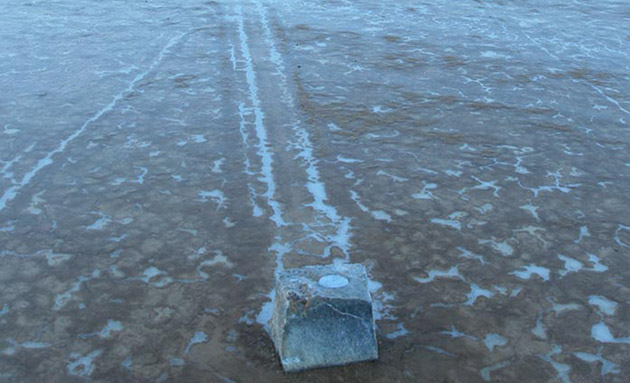 GPS-instrumented rock with its rock trail.The GPS unit with its battery pack is inserted into a cavity bored into the top of the rock. The GPS continuously logs its position after a switch is triggered by the stone moving away from a magnet set in the playa. The surface of the playa is frozen in this image, but the ice had melted or was floating when the trail formed. (Mike Hartmann) A week before Christmas in 2013, the cousins returned to Death Valley to check on their rocks. That’s when they found all the elements needed to explain the phenomenon: a playa covered with ice, some afternoon sunshine and a light, steady wind. "Suddenly, the whole process unfolded before our eyes," Richard Norris told the L.A. Times. They heard the ice crack. They saw the rocks begin to sail. James Norris grabbed a camera — and their photographs became the final piece needed to help solve the decades-long puzzle. "The largest observed rock movement," they wrote in their study, involved more than 60 rocks on Dec. 20, 2013, some of which moved up to 224 meters, or more than 700 feet, between December 2013 and January 2014 in "multiple move events." "There was a side of me that was wistful because the mystery was no more," James Norris told the L.A. Times. 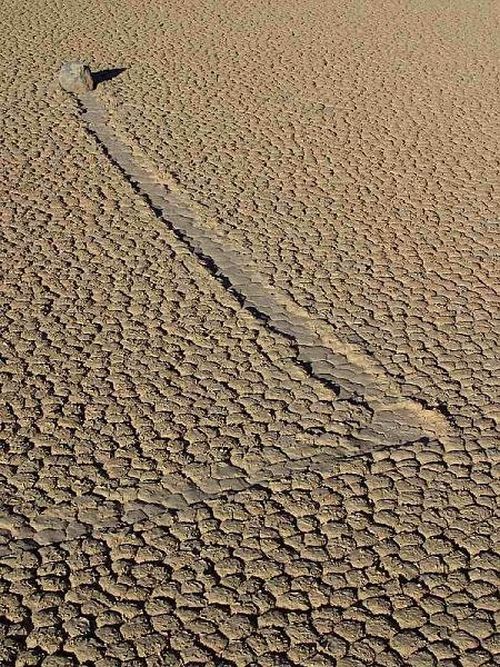 comments powered by Disqus Submit News/Videos/Links | Discuss article | Article Link | More Unsolved and Unexplained Mysteries |
More can be addded on request. Direct your requests at vinit@theunexplainedmysteries.com
